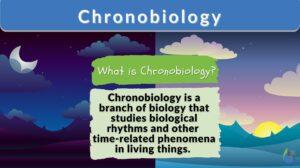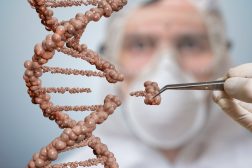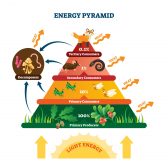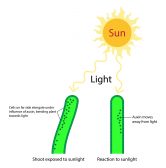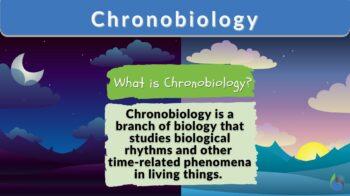
Chronobiology
n., [ˌkrɒnəbaɪˈɒlədʒɪ;]
Definition: branch of biology that focuses on time-related phenomena in living organisms
Table of Contents
Chronobiology Definition
Chronobiology is a branch of biology that studies time-related phenomena (e.g., biological rhythms) in living organisms. Biological rhythms are synchronized cyclic patterns observed in organisms. Examples of biological rhythms are circadian rhythms, diurnal rhythms, ultradian rhythms, and infradian rhythms. These cyclic patterns are driven by the “biological clock“.
Chronobiology encompasses other fields of study such as anatomy, genetics, physiology, and behavior. Understanding biological rhythms is essential in predicting the physiological and behavioral patterns of a biological system. An expert in this field is called a chronobiologist.
Etymology: chrono– + G. bios, life, + logos, study.
Related form: chronobiological (adjective)
Synonyms: biorhythmics
Chronobiology Basic Concepts
Biological Clock Definition
A biological clock is one that synchronizes biological rhythm. It gives the organism a “sense of time”. The human body clock, for instance, helps regulate the biochemical and physiological activities such as sleep and wakefulness cycle, body temperature, patterns of hormone secretion, blood pressure, digestive secretions, alertness levels, reaction times, etc.
Biological Rhythms Definition and Types
A biological rhythm is defined as any of the synchronized cyclic patterns displayed by an organism in response to a stimulus. The different types of biological rhythms are circadian rhythms, diurnal rhythms, ultradian rhythms, and infradian rhythms.
It may also be endogenous or exogenous. Endogenous biological rhythms proceed from within, such as the biological systems regulating body temperature cycles and menstrual-associated rhythm. Exogenous biological rhythms are rhythms or patterns that are influenced externally, such as light that serves as an external cue for sleep and wakefulness pattern.
What are Zeitgebers?
External cues involved in biological rhythms are particularly referred to as zeitgebers. Examples of these external cues are light and temperature.
Types of Biological Rhythms
- Circadian rhythms
Circadian rhythms are endogenously-driven biological rhythms with a period of 24 hours or close to it. Diurnal rhythms are biological rhythms synchronized with the day/night cycle. - Ultradian rhythms
Ultradian rhythms are biological rhythms with a cyclic period shorter than 24 hours. Examples are blood circulation, pulse, and heart rate. - Infradian rhythms
Infradian rhythms are biological rhythms with a period longer than 24 hours. Examples are the menstrual cycle in women, animal migration, and hibernation.
Circadian rhythmicity is a built-in system in the living organism that accounts for the 24-hour rhythmic pattern. A circadian control has these common features: firstly, an endogenous free-running close to a 24-hour period, secondly, a rhythm that is entrainable (meaning, it is capable of phase reset by environmental cues and synchronization to the 24-h day), thirdly, exhibiting temperature compensation (meaning, the rhythmic periodicity is stable across differing temperatures), and lastly, being capable of adjusting to the presence of exogenous signals like light or heat and even in the absence of these cues, the patterns will still be manifesting. (Andreani et al., 2015)
Human Chronobiology
Chronobiological studies in humans are aimed typically at determining the anatomical, physiological, molecular, and/or genetic basis of organisms related to their biological rhythms.

The Central Clock
Where is the circadian clock located in the human body? The master circadian clock is located in the suprachiasmatic nucleus (SCN) in the hypothalamus of the human brain (similar to other mammalian brains). This part of the hypothalamus consists of multiple neurons (about 20,000 neurons) that receive signals from the eyes and other regions of the brain.
The output of the SCN is directed to the hypothalamus, which in turn regulates the functions of various parts of the body and the brain.
The master timekeeper resides in the SCN but it is not the only place where circadian clocks are found. Other internal or endogenous clocks are located in various tissues and organs, especially those involved in homeostasis. An example of that would be the clock system in the liver for glucose metabolism and homeostasis. The master clock though is believed to work in sync with these “local” clocks in other bodily parts, such as the liver, muscle cells, connective tissues, lungs, and so on.
Question: How does the SCN control circadian rhythms in humans?
Answer: Signals from the eye (photic input) and other brain regions (nonphotic input) are conveyed to the SCN. This eventually leads to the expression of the genes (clock genes) in the SCN that are responsible for the transcription of various regulators (“clock proteins”) of circadian rhythms. These “clock protein” regulators are produced at levels that rise and fall in an oscillating rhythmic pattern.
Signals from SCN are then conveyed to the other parts of the brain, particularly the hypothalamus — the main control center for the autonomic nervous system and has a role in diverse physiological functions and processes, such as thermoregulation, blood sugar regulation, fat metabolism, hunger-thirst regulation, attachment behavior, sleep patterns/sleep periods/sleep quality, etc.
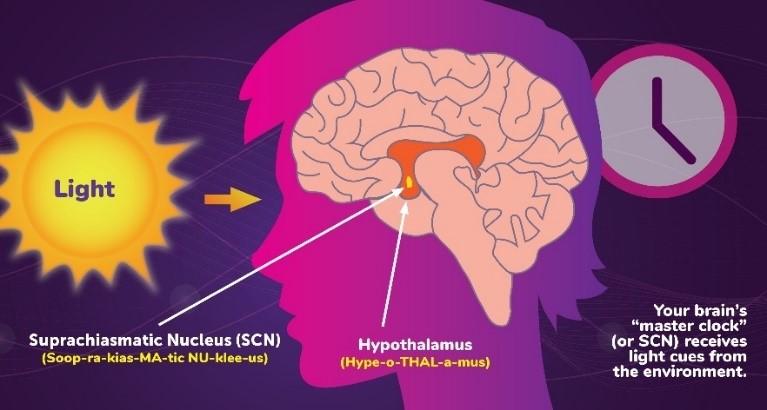
The biological clock of the human body drives various behavioral and physiological processes that indicate a rhythmic pattern, such as the sleep-wake cycle, core body temperature, hormone secretion patterns, blood pressure patterns, levels of alertness, and digestive secretion patterns.
Studying Circadian Rhythms in Humans
Chronobiology research is vital to understand human circadian rhythms and how human health can be improved through genetic studies (using animal models), and one that can be applied and investigated in clinical settings, developing technology that can measure circadian rhythms, especially for the critically-ill patients (those in intensive care unit), and coming up with solutions with therapeutic implications.
Here are some common circadian rhythms that have been the major focus of chronobiology over the past few decades:
Sleep-wake cycle
In this circadian rhythm, the circadian factors are light and darkness, which is in sync with the 24-hr rotation of the Earth. Although light and darkness are crucial environmental factors, these external cues are not required for circadian clocks to persist. Still, they have the tendency to control circadian rhythms by affecting the melatonin levels produced in the body. In humans, the SCN produces proteins that act on the pinealocytes of the pineal gland to secrete the hormone, melatonin (which induces sleep). The SCN clock makes sure that melatonin secretion occurs at night. How long melatonin is produced is affected by the duration of nighttime. Thus, melatonin production for extended periods is likely during long winter nights.
Daily rhythms in body temperature
In humans, the body temperature follows a pattern where it is relatively high in the daytime and then low at nighttime.
Cognitive performance
Some animals are more alert and with high cognitive performance in the daytime. Such animals that are typically awake and active during the day are referred to as diurnal animals. The opposite holds true for nocturnal animals. They are more alert at night time than in the daytime.
Disruption of the Biological Clock in Humans
There are instances by which biological clocks are shown to be disrupted. Examples are jet lag, shift work, old age, and mutations or variations in clock genes. Sleep disturbances may well impair human health. In time, it may lead to chronic conditions such as depression, diabetes, metabolic disorders, seasonal affective disorders, and cardiovascular disease.
Jet lag
Traveling by air to a place at a different timezone can make one feel dizzy and extremely tired. This condition due to circadian rhythm disruption caused by air travel across time zones is called “jet lag”.
Shift work
Shift workers also tend to suffer from disturbed sleep patterns or sleep deprivation. Referred to as “shift work sleep disorder”, the person who works rotating shifts or at night will experience excessive sleepiness at night while finding it difficult to sleep during the day. Other symptoms include headaches, inability to focus, and lack of energy resulting in poor performance, poor health, irritability, heightened risk of accidents and errors, and impaired social functioning.
When there is not enough light, the SCN tends to “tell” the brain to produce more melatonin, making one feel drowsy.
Common advice to deal with sleep disturbances based on research:
- Light exposure should be minimized especially for shift workers. Exposure to light, e.g., sunlight, resets the rhythm every day, thus, enabling the body to synchronize with the 24-hour period.
- Blue light (380 to 500 nm) has been found to be a potent melatonin suppressant. Thus, exposure to blue light at night or before bedtime may disrupt the body’s ability to prepare to sleep. Examples of devices emitting blue light are laptops and other computer screens, smartphones, tablet screens, Flat screen LED TVs, fluorescent light, LED light, and CFL bulbs.
- Constant routines and good sleep hygiene are advised at bedtime, as well as keeping a regular sleep schedule.
- Sleep meds are medically-prescribed to help promote quality sleep and energy balance when sleeping has persistently become difficult.
- Alarm clocks may disrupt deep sleep and thus it is advised to adjust sleep hours to minimize the dependency on alarm clocks over natural circadian rhythms for waking up.

Clock Genes and Variations
Clock genes (genes regulating biological rhythms and thus may affect circadian rhythms) have been discovered by scientists over the course of time, especially by using animal models like fruit flies that have a similar genetic makeup to humans. (National Institute of General Medical Sciences, 2019)
Examples of clock genes identified so far are period (per), clock (clk), timeless (tim), frequency (frq), doubletime (dbt), cycle (cyc), etc.
In 2001, a human clock gene was discovered by scientists from the University of Utah when they studied sleep disorders associated with the mutation in the hPer2 gene. People carrying this type of gene tend to sleep early (e.g., 7 pm) and then wake up before dawn (e.g., 2 am). This sleep pattern caused by a mutation in the hPer2 gene is called “familial advanced sleep phase syndrome” or FASPS. (The Time of Our Lives, 2016)
Another unusual sleep pattern linked to clock gene mutations (hPer3 gene variation) is “delayed sleep-phase syndrome”. Quite the opposite of FASPS, the individual with this type of condition tends to sleep very late at night and finds it difficult to wake up early in the day.
Common Chronobiological Tools
Here are some research methods/techniques in clinical practice and potential treatments relevant to human circadian rhythms:
- Dim light melatonin onset (DLMO) Test: The human body starts to produce melatonin in the evening when the light is dim (at around 8 pm), thus the name. DLMO test has been used in measuring circadian rhythms with respect to melatonin levels. It is a common diagnostic tool in determining circadian rhythm disorders. The test is done usually from 8 pm to 3 am, taking saliva samples (in the form of chewed-on cotton balls) to be measured afterward for melatonin concentration.
- Light therapy devices: The commonly used devices used in light therapy (e.g., bright light therapy) are light boxes, desk lamps, light visors, and dawn simulators.
- Electroencephalogram (EEG). This is used by healthcare professionals in measuring brain wave activity and diagnosing sleep disorders
Plant Chronobiology
Apart from humans and animals, plants also do show circadian rhythms. They also exhibit circadian cycles and have special circadian physiology that follows diurnal patterns. Photoperiodism, for instance, is one of the many indications of circadian rhythms in plants.
Photoperiodism, in fact, can be used to categorize plants based on how they respond to light intensity and length of uninterrupted darkness.
Short-day plants, as the name suggests, are plants that bloom only when they are exposed to less than 12 hours of light (or longer periods of darkness). Conversely, long-day plants are those that bloom when they are exposed to more than 12 hours of light (or shorter periods of darkness). Thus, there are plants that can be seen blooming during spring and fall (e.g, poinsettias and chrysanthemums), and then there are those plants that bloom during summer (e.g., asters and coneflowers). Day-neutral plants, though, are plants that flower regardless of day length, and thus, will produce flowers be it summer or autumn (e.g., corn and tomatoes).
Read this Tutorial to understand how light affects plants.
Chronobiology in Prokaryotes
Cyanobacteria are so far the only prokaryotes that have been well-documented to have shown circadian rhythmicity. Researchers have documented the circadian molecular mechanisms by which cyanobacteria are able to “tell” time. Their circadian clock is made up of three proteins: Kai A, Kai B, and Kai C.
Watch this vid about cyanobacteria and the molecular system they use for cellular rhythms:
Take the Chronobiology Quiz!
References
1 Hedge, A. (2013). Biological Rhythms. Retrieved from http://ergo.human.cornell.edu/studentdownloads/dea3250pdfs/biorhythms.pdf
Andreani, T. S., Itoh, T. Q., Yildirim, E., Hwangbo, D.-S., & Allada, R. (2015). Genetics of Circadian Rhythms. Sleep Medicine Clinics, 10(4), 413–421. https://doi.org/10.1016/j.jsmc.2015.08.007
News-Medical. (2018, August 2). How Does the Suprachiasmatic Nucleus (SCN) Control Circadian Rhythm? News-Medical.net. https://www.news-medical.net/health/How-Does-the-Suprachiasmatic-Nucleus-(SCN)-Control-Circadian-Rhythm.aspx
National Institute of General Medical Sciences. (2019). National Institute of General Medical Sciences (NIGMS). https://nigms.nih.gov/education/fact-sheets/Pages/circadian-rhythms.aspx
The Time of Our Lives. (2016). Utah.edu. https://learn.genetics.utah.edu/content/basics/clockgenes
What are short-day and long-day plants? (2022, January 29). Life at OSU. https://today.oregonstate.edu/news/what-are-short-day-and-long-day-plants
©BiologyOnline.com. Content provided and moderated by Biology Online Editors.

